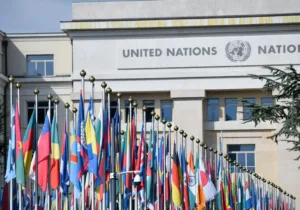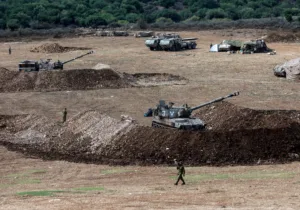I remember under-the-desk safety drills during the 1962 Cuban Missile Crisis with the Soviet Union. Heaven forbid Iran would follow in Russia’s footsteps in the future using Cuba as a launching pad for nuclear-tipped ICBMs. Yet, anything is a possibility in our uncertain world; maybe we would then finally understand Israel’s anxieties in their own neighborhood since only 90 miles separate Cuba and the United States. In the same way the Soviet Union used Cuba, Iran may be turning the island into a “Little Iran.”
Come with me on a quick tour to understand the context of a possible Little Iran off the coast of Florida. Since the 2015 implementation of the Joint Comprehensive Plan of Action (JCPOA, or Iran Deal), Israel and the United States still scrutinize Iran’s rogue actions. And well they should.
Iran’s violent rhetoric against Israel continues unabated, and like their North Korean friends, the Iranians are violating agreements on ICBM testing. Supplying weapons without let-up to its surrogates Hezbollah, Syria, and Hamas, the ignominious description as the world’s largest sponsor of terror doesn’t faze Iran’s apocalyptic, theocratic leaders. It’s all about dominance and hatred for Israel and ultimately the United States of America.
One over-arching indication of Iran’s push for regional dominance is also the palpable worry among the region’s Arab states. During President Trump’s first stop in Riyadh on his recent nine-day overseas trip, he re-emphasized Iran’s dangers in his speech to fifty leaders of Muslim-majority countries who attended. He urged them to do their part and unite against terror. Earlier, he spoke during a closed meeting with the Gulf Cooperation Council composed of Bahrain, Kuwait, Oman, Qatar, Saudi, and the United Arab Emirates. Hopefully, in this private meeting he was even more forceful.
While justified, disquiet is ever-present in the Middle East due to Iranian hegemonic threats. Yet, we cannot overlook Iran’s history and interest in our Latin American neighbors. Evidence abounds linking Venezuelan narcotics cartels which finance terrorism through organizations like Iranian proxy Hezbollah. But Venezuela, long an ally of Iran, is now sinking beneath a socialist dictatorship fomenting widespread food shortages, riots, and economic disaster among its citizens.
As serious as narco-terrorism is, it poses only one area of concern. Florida Representative Ileana Ros-Lehtinen in testimony before the US Congress in 2011 stated, “Iran has opened up more than 80 cultural centers in Latin America to export its toxic brand of political influence…focusing on partnering with nations well known for their anti-American rhetoric.”
Now with national disaster transpiring in Venezuela, will Iran increase its relationship with communist Cuba?
Since 1960, Cuba and Iran have cooperated on various levels, including trade. The relationship accelerated after Iran’s 1979 Islamic Revolution. When the United States implemented a series of effective sanctions against Iran, Cuba and Iran found mutual enmity against the United States.
Fast forwarding to March 2016, President Obama visited Cuba and stated in an NPR interview, “Cuba is a circumstance in which, for 50 years, we have done the same thing repeatedly and there hadn’t been any change—should we try something different with a relatively tiny country that doesn’t pose any significant threat to us or our allies?”
And like the Iranian deal, the President exacted no demonstrated behavior changes from the Communist regime before the US extended any rewards. Iran and Cuba gleefully gobbled up the carrot on the stick with ease.
Then in August 2016, Iran’s Foreign Minister Zarif embarked on a Latin American tour including Cuba to establish more expansive ties in five nations. This occurred after the United States, as part of their misbegotten Iran deal, released 1.3 billion dollars to Iran in early 2016. Zarif said, “It’s a very opportune moment to extend our relations. We have always been on the side of the great Cuban people in the face of the atrocities and unjust sanctions they have faced, and vice-versa.”
Iran’s President Hassan Rouhani followed quickly behind and visited Cuba in September. While there, Rouhani clearly articulated Iran’s goal to increase both Cuba and Iran’s technology cooperation, especially in nano- and bio-technology.
After these three-in-a-row significant visits to Cuba from Obama, Zarif, and Rouhani, The Hill in an October 2016 article entitled, “Cuba, Iran’s Island in the Sun,” opened with this sentence: “The Obama administration thinks Iran’s influence in Latin America is waning. That means it does not view the 80 or so cultural centers Iran has established across Central and South America as a threat.”
The same article also cited Cuba’s laws against proselytizing—ask any Christian pastor! However, the Castro brothers welcomed a Shiite mosque and seemed to have no problem with Iran’s missionary outreach. The number of converts is small, but Cuba’s communist government has made quite an exception. Dictators disregard laws when it’s convenient.
While not a top item in the 24/7 news cycle, an Obama directive in October 2016 shows a trustfulness beyond comprehension. Obama ordered Gen. James R. Clapper, then US Director of National Intelligence, to collaborate with Cuba’s intelligence services. Can you imagine Cuba not being an intelligence bonanza for Iranians? Thankfully, members of Congress expressed deep concern and skepticism.
A trail emerged in 2016 with clear signposts: Iran deal went forward. More than 1 billion dollars landed in Iranian coffers. Obama visited Cuba. Iran’s Foreign Minister Zarif visited Cuba. Iran’s President Rouhani visited Cuba. Obama opened intelligence sharing with Cuba. Congress was worried.
So…what’s my point? Do we have a plan to protect America’s backdoor when it comes to Iran, the world’s largest sponsor of terror? Or will we allow Iran to develop a proxy 90 miles from our shores?
—
For more information, I found two articles informative: Jaime Suchlicki’s article in Center for Security Policy and Adam Kredo’s article in Free Beacon.
—
Arlene Bridges Samuels is a pro-Israel activist, writer, and consultant who served for nine years as Southeast Regional Christian Outreach Director with AIPAC, America’s leading pro-Israel lobby. Prior to AIPAC, she worked as Executive Director and Media Liaison for Israel Always and Front Page Jerusalem Radio. She is currently Leadership Outreach Director for American Christian Leaders for Israel, a project of the International Christian Embassy Jerusalem.
During her tenure with AIPAC, she staffed nine American Israel Education Foundation trips to Israel for Christian leaders and pastors, built a network of pro-Israel Christian advocates with the US Congress, and spoke in venues throughout the southeast and nationally.
Arlene received her BA from Winthrop University in Rock Hill, SC. On full scholarship, she received her Master’s degree from the University of Alabama in Tuscaloosa, Alabama. Prior to her pro-Israel staff positions, she and her husband served for eight years with Mercy Ships, the world’s largest private hospital ship.
Photo Credit: The Capitolio Nacional in Havana, Cuba. By Dan Lundberg, via Flickr.






